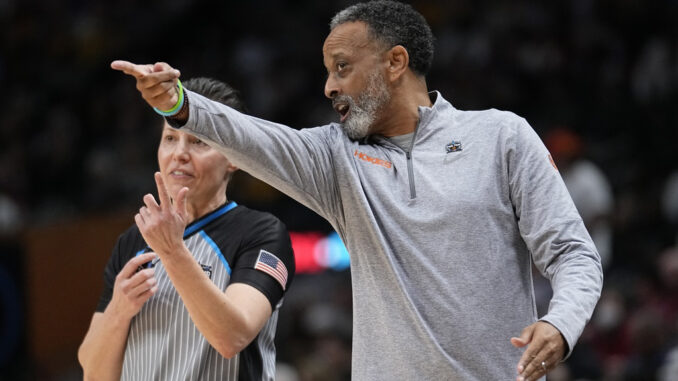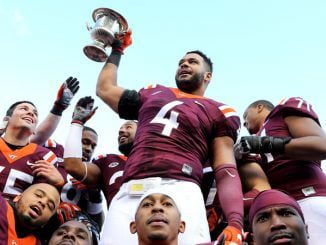
CHARLOTTE — Old guys at barber shops and diners around the nation can rejoice. Traveling is back in college basketball.
While the graybeards normally gripe about referees no longer making the call, this is a different type of traveling altogether.
“We saw 10 teams over there while we were there,” said Georgia Tech women’s coach Nell Fortner of her team’s multicountry trip to Europe over the summer. “We’re in Croatia, and look at that! There’s Florida State!”
The Jackets visited Spain and Croatia. The Seminoles went to Greece and Croatia. Six other ACC women’s teams and four men’s squads also flew over the pond this summer. Clemson’s women went to Greece. Notre Dame’s went to Croatia and Greece and are headed to France to start the regular season. Pitt’s men hit Spain. Boston College’s women were in Italy, and the men went to Italy and Spain. Miami’s women went to France and Greece, while the men took an 11-day trip to France. Virginia Tech sent its women’s team to Greece and the men to Switzerland and Italy. Louisville’s women went to Canada and the Virgin Islands (both the U.S. territory and the British Virgin Islands).
Looking at all the Division I programs, 59 women’s teams and 96 men’s squads took international trips, spending a total of more than four years — 620 days for the women, 897 for the men — outside the U.S. The Big Ten had 15 teams (eight women, seven men) take trips, the Big 12 had 14 (four women, 10 men). The Pac-12 had 14 teams, the ACC 13, SEC 11 and Big East 8.
Don’t forget the 85 teams from midmajor conferences (26 women, 59 men) that also sent their teams abroad. UNCG went to France and Senegal. Cal Baptist’s men and Southern Utah’s women both managed to fund trips to Australia. Radford went to Japan, UC-Irvine traveled to China.
A total of 28 different countries were visited by an American collegiate basketball team this summer. Italy was the most popular destination, hosting 24 men’s and 24 women’s teams. Greece had 34 visiting teams, Spain 26. Itineraries spanned the globe, from Ireland to Israel, Slovenia to Slovakia to Senegal. Teams went to all six populated continents, and it might be foolish to rule out a Great Antarctica Shootout in the future.
Of course, international travel is nothing new for college basketball teams. Programs have gone overseas during the offseason for generations. There’s obviously a recruiting benefit to high-profile trips to exotic locales. It also gives teams extra practice time and life on the road, which is always good to help teams jell — something that’s even more crucial with the transfer portal shuffling rosters like never before. Still, the flying has never been quite as frequent or widespread as it was this year.
The reason for that? The acronym that seems to be behind everything that’s changing in college sports these days: NIL.
The NCAA allowed athletes to profit on their name, image and likeness with a change to the rules a few years ago. It created a Wild West environment of questionable payments, shady deals and outright accusations of cheating from one coach to another.
Turns out, everyone might have been understating just how sketchy the NIL world really is.
“It was a little NIL vacation,” said Louisville women’s coach Jeff Walz of his team’s trip to Canada and the Virgin Islands. “We can’t give them any NIL money, but we can give them experiences. That’s what we did.”
It’s true that schools can’t directly provide student-athletes with NIL cash, but they can make it very easy for everyone on the roster to cash in, and that’s the real reason players are being told to show up on campus with their passports renewed.
To see what exactly is going on, let’s look at the rosters of the women’s ACC teams that took trips compared to the ones that didn’t. The eight teams to go overseas this year feature a combined 25 international students on their rosters. All eight have at least one, and six of them have multiple. Georgia Tech, which visited Spain, has three Spanish students, as well as a Lithuanian and a Canadian. Louisville, which played in a tournament in Canada before heading to the Virgin Islands, has a player from Canada as well as others from the Netherlands, Nigeria and Turkey.
The seven ACC teams that stayed inside U.S. borders this summer have a combined 12 international players, fewer than half as many as the ones that went overseas. Only three have multiple international players, and one, UNC, has none.
The men’s teams show a similar pattern: Teams that stayed in the U.S. have an average of 1.6 international players on the roster. The ones that took trips have 2.5.
Most international student-athletes are in the U.S. on F-1 student visas, which prohibit them from earning income from off-campus employment. As everyone knows, NIL money must come from off-campus sources. That means that international players can’t cash in on their name, image or likeness — at least when they’re inside U.S. borders.
Louisville’s Merissah Russell said, “I’m actually an international student. I’m from Canada. I can only do deals when I’m on Canadian soil.”
After playing four games in Toronto, Louisville went to St. Thomas and St. John in the U.S. Virgin Islands, holding a practice and hosting a clinic for local players. Also on their itinerary was a side trip. “We took them over to the BVI (British Virgin Islands),” Walz said. “International kids, you’ve got to take them out of the U.S. to be able to earn any NIL opportunities.”
These trips were paid for, largely, thanks to donors to the athletic program, and many of the largest donors got to accompany the team on the trip they helped support. That added yet another benefit for the international players. The people most likely to hook them up with lucrative NIL deals were right there next to them when they set foot outside of the United States.
“We had tremendous donors that helped us along the way,” said Virginia Tech women’s coach Kenny Brooks of their international trip.
“We had a large group of donors and supporters with us,” said Miami coach Katie Meier.
So, while the UNC women (no international players) went whitewater rafting in Charlotte, the UVA women (1 international player) took a team trip to New York City to watch the WNBA Finals, and Wake Forest’s women’s team (1 international player) went ax throwing in Winston-Salem, much of the rest of the league was traveling the world and coming back with their pockets a little fuller than when they’d left.
“It’s just a matter of figuring out the rules and playing within the rules,” said Walz.



